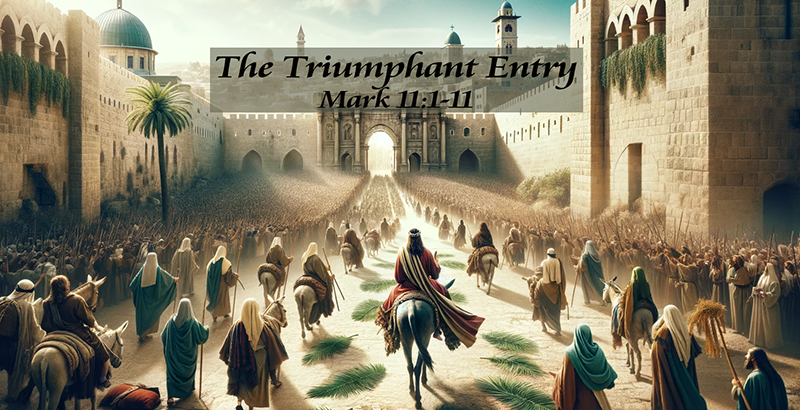Verse-by-Verse Commentary
Mark 11:1 - "As they approached Jerusalem and came to Bethphage and Bethany at the Mount of Olives, Jesus sent two of his disciples," This verse sets the geographical stage, highlighting the strategic and prophetic significance of the location. The Mount of Olives is directly east of Jerusalem and is associated with vital prophetic events regarding the coming of the Messiah (Zechariah 14:4). Jesus’ approach from this direction is symbolic, aligning Him with messianic expectations.
Mark 11:2 - "saying to them, “Go to the village ahead of you, and just as you enter it, you will find a colt tied there, which no one has ever ridden. Untie it and bring it here." Jesus’ specific instructions demonstrate His foreknowledge and control over the situation. The unbroken colt, which no one has ever ridden, symbolizes purity and the fulfillment of prophecy (Zechariah 9:9), emphasizing Jesus’ messianic identity and His inauguration of a new era.
Mark 11:3 - "If anyone asks you, ‘Why are you doing this?’ say, ‘The Lord needs it and will send it back here shortly.’” This directive highlights Jesus’ authority and the disciples’ reliance on His word. “The Lord needs it” signifies Jesus’ kingly status and divine authority, expected to be recognized and respected by those they encounter.
Mark 11:4 - "They went and found a colt outside in the street, tied at a doorway. As they untied it," The disciples’ experience unfolds precisely as Jesus had said, reinforcing His prophetic insight and the disciples’ faith in His instructions. This also shows the divine orchestration of events leading to His triumphant entry.
Mark 11:5 - "some people standing there asked, “What are you doing, untying that colt?” This moment of interrogation by the bystanders tests the disciples’ faithfulness to Jesus’ instructions and their trust in His words. It reflects a moment where human action intersects with divine purpose.
Mark 11:6 - "They answered as Jesus had told them to, and the people let them go." The response of the people, allowing the disciples to take the colt after hearing Jesus’ authority invoked, underscores the recognition of Jesus’ lordship by those present, fulfilling Jesus’ instructions and affirming His control over the situation.
Mark 11:7 - "When they brought the colt to Jesus and threw their cloaks over it, he sat on it." The disciples’ actions of placing their cloaks on the colt for Jesus to sit on are acts of homage and recognition of Jesus’ kingship. This mirrors Old Testament practices of acknowledging someone as king (2 Kings 9:13).
Mark 11:8 - "Many people spread their cloaks on the road, while others spread branches they had cut in the fields." The spreading of cloaks and branches on the road before Jesus is a significant act of royal acclamation and messianic expectation. It is an act of worship and recognition of Jesus as the long-awaited King, reminiscent of welcoming a victorious ruler.
Mark 11:9 - "Those who went ahead and those who followed shouted, “Hosanna! Blessed is he who comes in the name of the Lord!” The cries of “Hosanna!” (meaning “save, we pray!”) are a direct quotation from Psalm 118:25-26, a messianic psalm. This public declaration acknowledges Jesus as the Messiah, who comes in God’s name to save His people.
Mark 11:10 - “Blessed is the coming kingdom of our father David! Hosanna in the highest heaven!” This proclamation connects Jesus with David’s royal lineage, affirming Him as the rightful heir to David’s throne and the fulfiller of God’s promises to David. The phrase “Hosanna in the highest heaven” is a plea for divine salvation from the highest authority.
Mark 11:11 - "Jesus entered Jerusalem and went into the temple courts. He looked around at everything, but since it was already late, he went out to Bethany with the Twelve." Jesus’ entry into the temple and His observant survey of the surroundings hint at His authority over the religious establishment and foreshadow His upcoming actions in the temple. His retreat to Bethany with the Twelve indicates a temporary withdrawal to prepare for the events that will unfold in the coming days.
